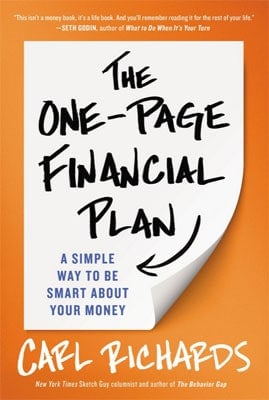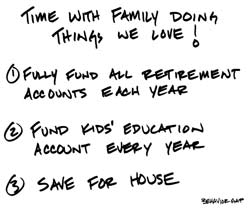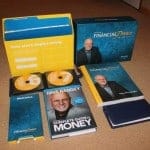People who are in debt often find themselves in a situation that’s emotionally overwhelming.
With so many financial details coming at them daily, many would love it if someone would just stop and give them a simple plan to help them get back on track.
The One-Page Financial Plan, by New York Times columnist and best-selling author Carl Richards, aims to give people a straight forward one-sheet financial overview that they can look to when the going gets rough, without getting overwhelmed in the details.
I recently had the opportunity to sit down with Carl Richards on a Google Hangout, along with my Money Mastermind Show compatriots. We talked about how the book came to be, whether or not his financial plan is really one page, and why having a one-page financial plan is a good idea. Here’s a look at that show, as well as a review of his book.
Quick Navigation
Saving For Retirement: We’re Behind
When it comes to planning for our future, and saving for retirement, a majority of us are falling behind.
The average working household has virtually no retirement savings. When all households are included— not just households with retirement accounts—the median retirement account balance is $3,000 for all working-age households and $12,000 for near-retirement households.
There is a huge retirement savings gap. Among working households, the collective retirement savings gap among 25-64 year olds ranges from $6.8 to $14 trillion, depending on the financial measure.
So why aren’t we saving? Because we’re neglecting to even put together the most basic of financial plans. It’s time to change that. Carl Richards attempts to do that with The One-Page Financial Plan.
 Discovery Of Why Money Is Important To You
Discovery Of Why Money Is Important To You
In part one of his book Richards talks about how important it is to discover your essential why behind your financial goals. Without that, you’re just wandering aimlessly without meaning. Why are you working hard and saving? Is it to spend more time with your family? To be able to retire early and travel? To give more to causes you believe in?
Once you’ve figured that out, it’s important to sit down and figure out three specific goals or action items that you can do in order to reach your ultimate why.
Boiled down to it’s essential parts, that’s what the one-page financial plan is:
One-Page Financial Plan Is:
- The WHY: Why are you working hard and saving (to spend more time with family and those i love)
- Goals: 3 specific things – action items – that you need to do to reach your goals – your why.
The one-page financial plan is extremely simple, and it’s designed that way on purpose. Richards explains that by keeping it simple, it helps people to overcome the anxiety that comes along with information overload – and too many options. Keep it simple, have a nice sketch overview you can regularly refer to as a reminder – and flesh out the details later.
The Most Important Money Question… WHY?
In part one of his book – titled “Discovery” – Richards talks about how important it is in the beginning to just get clear about where you are and where you want to be. To sit down and figure out what you want from money and from your life.
Often people skip the step of figuring out why money is important to them, and move right on to trying to figure out how to make more money, invest the money and so forth. In other words, they put the cart before the horse. The “WHY” becomes secondary, when in reality, it should be the primary thing.
When coming up with your one-page financial plan it’s important to come up with the broad sketch overview first, without worrying too much about the low level details. Focus on what’s important and make broad statements that can help to guide you.
In Richards view, the financial plan should be a snapshot, not a complete instruction book. It’s the picture on the front of the box – not full instructions. You’ll need to make changes to the plan when circumstances change and adapt and re-evaluate.
Guess Where You Want To Go
Once you’ve figured out why in your financial plan, it’s time to figure out your specific goals for achieving your why, identifying your priorities and balancing the trade-offs in your priorities.
- Identify priorities – balance trade-offs – prioritize your goals
In the book Richards talks about how coming up with your goals isn’t necessarily about getting things right – but about realizing that you’ll always get things at least a little wrong. It is important to realize that things aren’t always going to go as we planned, and allow for that. Instead of making solid plans, we should be guessing where we want to go in life, and not necessarily be worried about having rock solid 30-40 year plans.
You should be committed not to your guess of what your future will look like, but to constantly renewing those guesses and changing your plan over time.
Identifying Priorities/Goals
So how do you identify your priorities and goals? You look at how you invest your money, time, energy skill, and if need be – adjust your priorities when they’re out of whack.
- Time spent + money spent = what you really value.
Get Clear About Your Current Situation
Tracking your spending and budgeting are good ways to get at the truth of where our money is going, as opposed to the stories that we tell ourselves.
Compare your why, and your goals, and figure out if your spending and budgeting truly line up with them. If not, you may need to adjust.
So what should you do? Sit down and figure out your current situation first. What assets and liabilities do you have? What’s your income?
Spending and Saving

Budgeting
Budgeting isn’t just about the numbers, budgeting is about awareness
- Budgeting = awareness
Budgeting gives us insight into the gap between what we say is important to us and how we actually spend our money. Are our stated financial goals and priorities lining up with the reality?
In our talk with him on the Money Mastermind Show Richards suggested using one of the many financial software out there to aid you in coming up with a budget. He recommended You Need A Budget, the same budgeting program that I use and recommend. (use this link to save $6!)
Saving As Much As You Reasonably Can
In his book Richards talks about the importance of avoiding rules of thumb for saving (like “save 15% for retirement”) because they’re not in any way related to your current situation. What is good for one family to save, might not be good for another.
Instead he says you should save as much as you reasonably can can, depending on your situation, and your goals. For one person that might be 15%. For another 25%.
The key to saving is to get started saving as soon as you can. The earlier, the better. His keys to saving:
- Save as much money as you reasonably can
- Spend less than you earn.
- Don’t lose money to speculative investments.
Investing For The Long Term
When investing your savings, Richards suggests that you “Invest like a scientist” and remember the following things:
1. Diversify your portfolio: Buy low cost mutual funds that buy whole sectors of the market – index funds. Lower risk by diversifying holdings among domestic, international stocks and bonds.
2. Keep your costs low: The more you pay for your investments, the less money you’ll end up keeping.
3 There is correlation between risk and reward: Equities are higher risk, but tend to have higher reward over longer periods. If the market shows fluctuations, don’t panic.
While Richards was hesitant to give a one size fits all investing portfolio without knowing a person’s personal goals, dreams and investing horizons, he did give an example default portfolio (with the proviso that your own strategy should be tailored to you):
Default portfolio:
- Determine what money you’ll need in the next 10 years, leave it in CDs and Savings.
- 60/40 stocks and bonds split.
- 18 Percent in international stocks like Vanguard Total International Stock Index
- 42 percent in U.S. Stocks, such as Vanguard Total Stock Market Index Fund.
- 40 percent in safe fixed income bonds such as Vanguard Total Bond market Index fund.
Avoid The Big Mistake
One big key to succeeding financially is to avoid the big mistake in your financial life. Avoid taking out a mortgage you can’t afford, or student loans that you’re unable to pay back. Don’t handicap yourself from the outset.
How can you avoid the big mistake?
Get Help
It’s easier to recognize other people’s mistakes than our own. Find someone who can provide checks and balances for you.
Richards suggests finding a real financial advisor who will diagnose your situation before prescribing a plan of action, be open about their conflicts of interest, be transparent about fees and compensation and stand between you and big financial mistakes. Avoid those who are just looking to sell you something.
Beware of your weaknesses and put up guardrails to keep you on the right path.
Have A Plan, And Stick To It
Carl Richards final words of wisdom included the following:
- Have a plan and stick to it: Come up with a why and a plan, and then stick with it – but also be willing to revise and re-engage.
- Automate good behavior: Automate savings, investments, auto-pay loans. Make decisions automatic and reduce the temptation to cheat.
- Remember, remember, remember: Learn from past behavior, and do your best to not make the same mistakes.
- Leave it alone: Like a tree, investments are best left alone for them to grow over time.
The One-Page Financial Plan by Carl Richards was a quick read, I finished it in an afternoon. While it wasn’t the longest book I’ve ever read, it certainly had no shortage of financial wisdom.
I loved the idea of having a financial plan that was a 10,000 foot view, something to remind you of what’s important in your life – your why. I think far too often our why gets lost in the shuffle, and the result is we end up leading lives devoid of the meaning that they should have.
Keep your why in mind, set goals in line with your why, and work towards those goals by implementing a sound, yet flexible, financial plan.
Have you read The One-Page Financial Plan? What are your thoughts?





Thanks for the review! This book is on my wish list/library list!
Glad I could help Heather!
perfect timing – I just checked it out from the library the other week but haven’t gotten around to reading yet
Hope you enjoy it!